How to Grow Herbs for Beginners
If you love the smell of fresh herbs and wish you had a farmers market right in your own backyard, then this guide on How to Grow Herbs for Beginners is exactly what you need. Learn the basics to get started growing your favorites from seed to harvest.
Jumpstart your gardening 101 with this awesome how to grow guide.
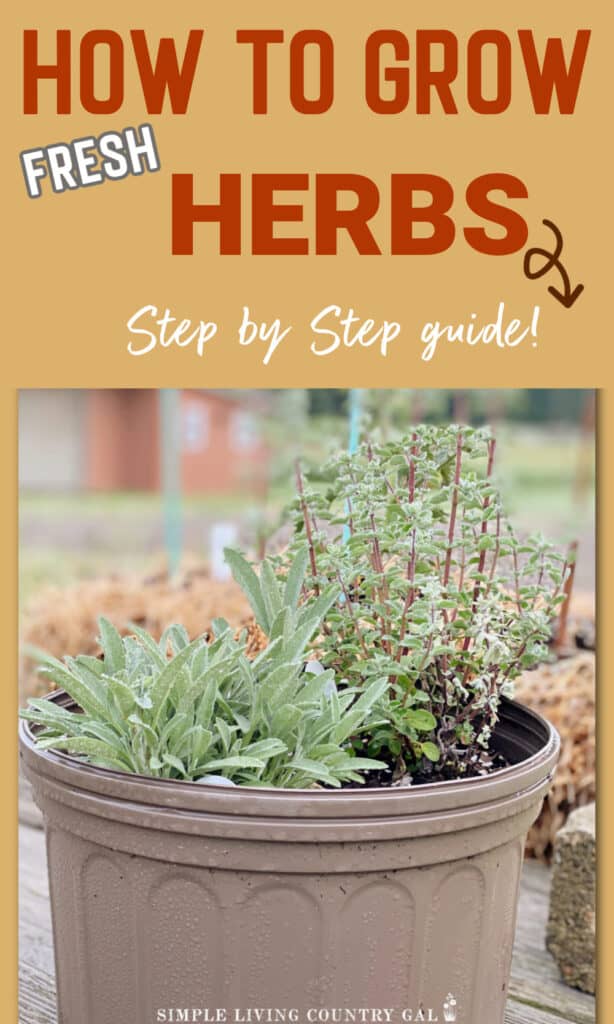
Herbs are a great addition to any garden; not only do they smell amazing even while growing, but they also support the growth of neighboring plants. Herbs make wonderful companion plants for many vegetables because their scents deter many insects and pests.
Uses for Fresh Herbs
Fresh herbs have many wonderful uses, such as bringing boring dishes to life and providing a delicious flavor boost. They can also be added to natural cleaning products to kill germs and add a fresh scent to your home.
How to simmer herbs for a natural room deodorizer.
Herbs smell amazing and work great to freshen the scent of any room.
- Place a few fresh cuttings of your favorite herbs into a small simmer pot.
- Add a few cups of water.
- Simmer on low heat and fill your kitchen with a lovely fresh scent.
Herbs can be used fresh, or you can preserve them by drying or freezing giving them a longer shelf life. Add them to bottles of olive oil to make a diffused oil for cooking. Some herbs, like mint, also make a wonderful, caffeine-free tea.
Herb Preserving Resources:
With so many herbs to choose from and so many ways to use them, growing herbs can become slightly addictive. The best part is they easily grow in small spaces, so you can plant them almost anywhere.
Where you can grow herbs:
- In a garden to fill in space.
- In containers on a front porch or back patio.
- In straw bales, yes…straw bales!
- On a window sill in a kitchen
Some herbs are annual and biennial; others are perennial. Annual and biennial varieties are fast growing in the spring and summer, so you’ll always have some fresh herbs available during this time of year. Perennial herbs grow a little slower, so you’ll want to plan for a longer growing season.

A few varieties of common herbs to consider include:
Before we dive in, let’s first go over the differences between annuals and perennials. An annual is a plant that completes its growing cycle in one season. A perennial is a plant that continues to grow for 3 seasons or longer.
Annual and biennial
- Basil
- Coriander
- Dill
- Parsley
- Chamomile
- Chervil
- Marjoram (sweet)
- Summer Savory
- Lemon Grass
Perennial
- Mint
- Oregano
- Sage
- Thyme
- Rosemary
- Chives
- Comfrey
- Fennel
- Lemon Balm
- Horseradish
Seed or Plant?
Herbs can be grown from seed or plant and what you use will depend on where you live and how long your growing season is. In the north, it is best to grow herbs from plants to get a jump start on the growing season.
You can purchase starter plants at any nursery or grow them from seed indoors prior to planting.
Indoor Seed Starting Resources:
What You Need to Grow Herbs
Herbs can be grown in a dedicated herb garden, in your vegetable garden, or even around your flower beds to add more foliage. They like plenty of sun and prefer to be in a somewhat sheltered location to protect them from winds.
Although there are a few herbs that will do fine in a shady location like parsley, mint, lemon balm, and chives.
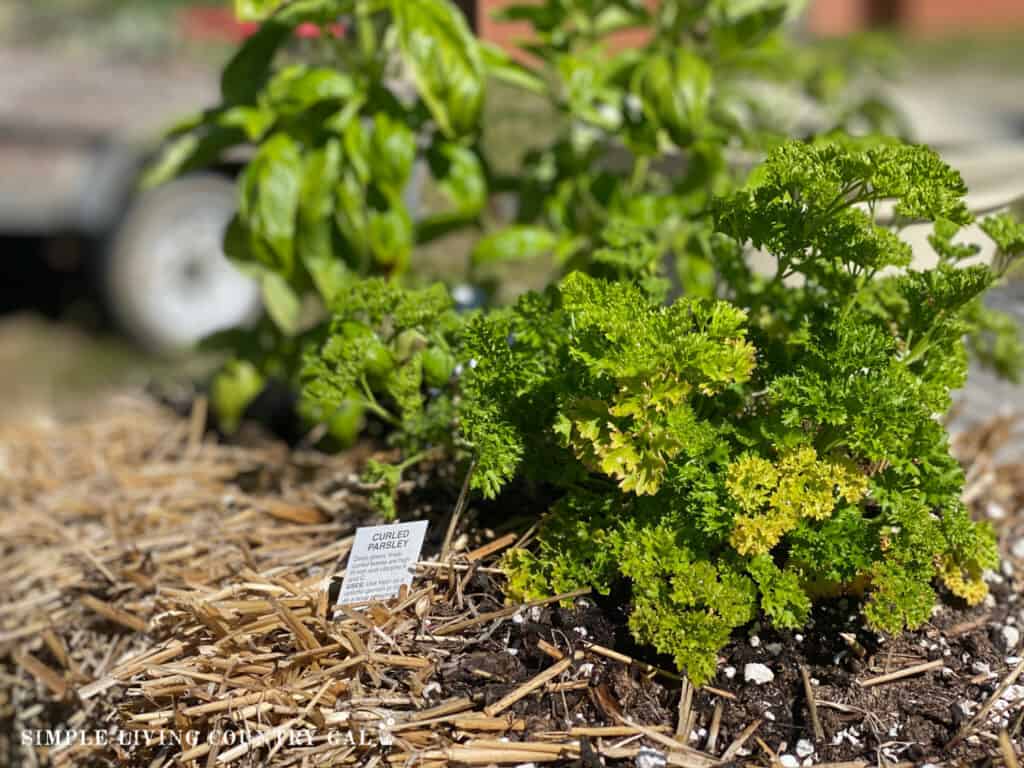
When to Plant Herbs
Herbs grow best in spring and summer which will make it best to plant in March or early April after the season’s last frost. Annual and biennial herbs can be planted as late as August. If you plant at 3-4 weeks intervals, you’ll have a constant supply of fresh herbs throughout the growing season.
Temperature
Herbs like it nice and warm, so be sure the ground has warmed up to at least 45° – 50° degrees before planting. They’ll flourish during the summer months and die out on their own as the temperatures cool down in the winter.
Sun
The more sun your herbs get, the better they’ll thrive. Ideally, they should get about 6-8 hours a day, but they’ll also do fine in slightly shadier spots, although they may grow slower. A few herbs will grow well in shady gardens. These include parsley, mint, lemon balm, chives, and chervil.
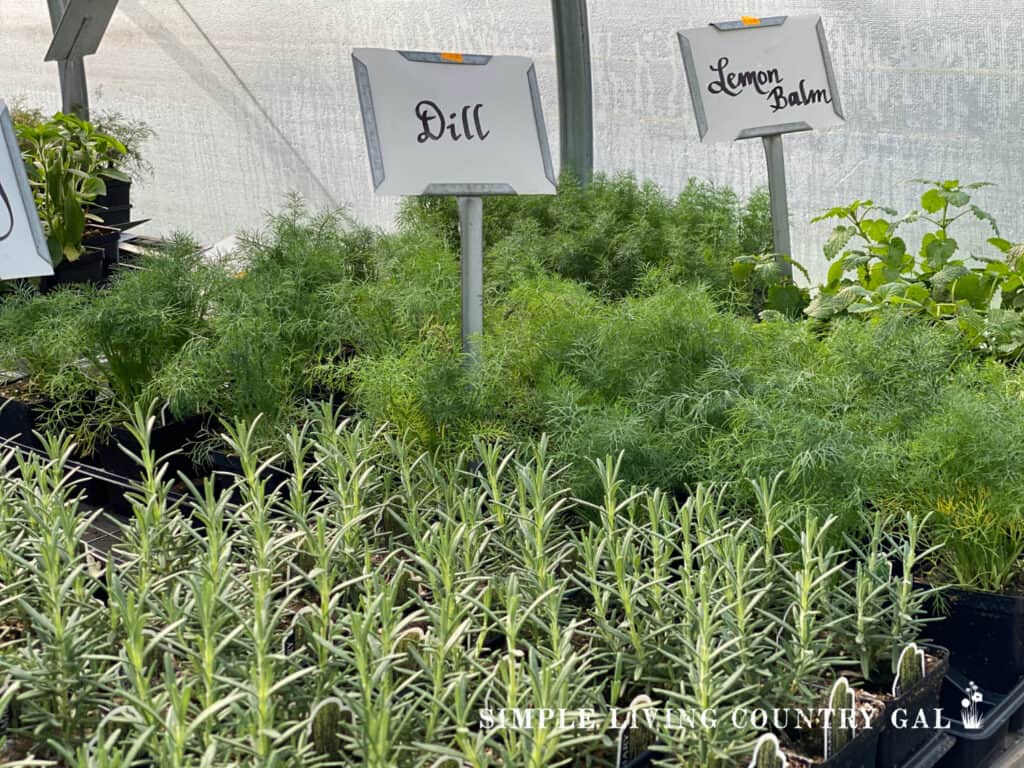
Soil
The soil should be well-draining. If you have heavy clay soil, incorporate some coarse grit and organic matter to loosen it up and improve drainage. Most herbs will tolerate soil that is slightly acidic, but the best pH level is neutral to alkaline. If your soil is too acidic, you can add lime.
Water
Keeping the soil moist but not too wet is the key to healthy herbs. The soil should be moist up to 6 inches deep. Water a few times a week, about an inch per week, but try to keep the watering at soil level and avoid getting the leaves wet as much as possible. Water in the morning so if the leaves do get wet, they’ll have plenty of time to dry before dark. Watering 2-3 times per week is preferable to daily watering to allow the plants to absorb the moisture between waterings.
Fertilizing
Overly fertilized soil can dilute the flavor of the herbs. If you need to add nutrients to the soil, a little compost mixed into the soil before planting will be enough. However, some herbs like basil, dill, and parsley grow better when fertilized regularly every 3-4 weeks.
Avoid using toxic pesticides since you will consume the full plant after harvest.
Support
Since herbs grow low to the ground, they don’t require a support system to hold them.
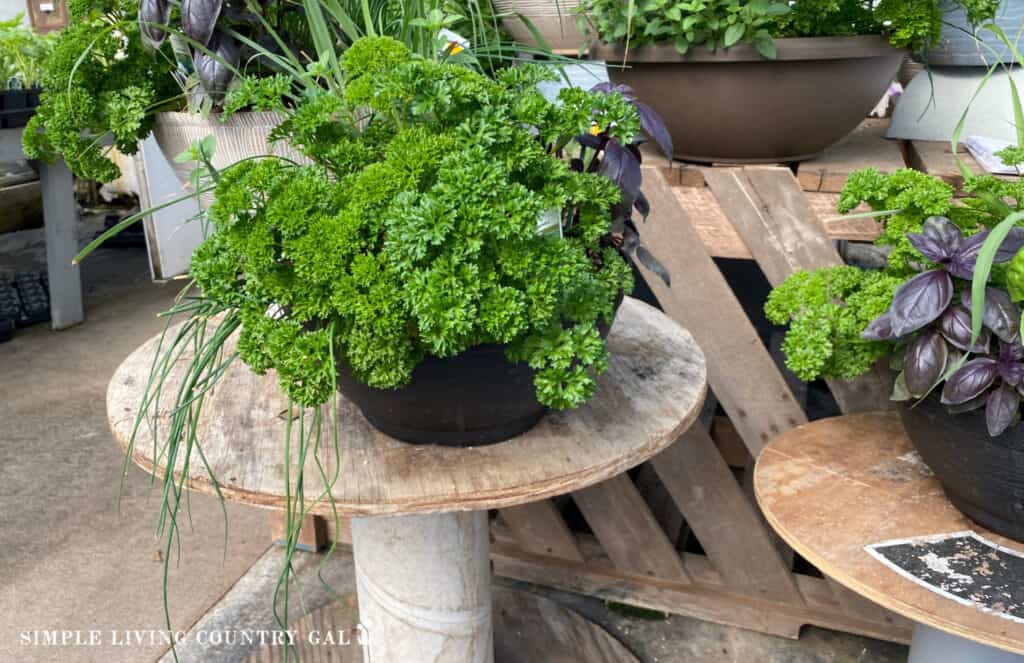
How Much to Plant
How much you need to plant is a personal preference. If you use a lot of fresh basil and rosemary, you may want to plant more than other herbs. If you like dill but only use it occasionally, you may want to plant less. A few seeds will provide a bounty of herbs, and they will continue to grow throughout the season, even when you pick the fresh leaves. Keep this in mind when deciding how much you want to plant.
A good rule of thumb is to start with 1-2 starter plants the first year and add on to that the following years if needed. Keep track of how much you plant and how much you use each year in a gardening journal. Your notes are quite possibly the most valuable resource you will have when gardening.
How Long Do Herbs Take to Grow?
The amount of time it takes for an herb to grow from seed to harvest varies based on the type of herb you plant. Most will sprout quickly and be ready to harvest in about 6-8 weeks. You’re ready to harvest once the plants are full and have plenty of leaves.
How to Plant Herbs
Herbs are easy to plant and can be planted all together in one area, throughout your garden, in containers, or even in bales of straw, wherever you have space. Starter plants or seeds can be planted about 6” – 8” apart. If you are planting seeds, plant them 6” deep. Grow herbs of the same variety together to support each other and allow about 12” – 18” between planting areas for different varieties.
Add a little compost and organic matter to the soil before planting to provide nutrients and ensure your soil is loose and well-draining. Once the seeds are planted, water well and keep the soil moist until they sprout. After your seeds sprout, you can water them just a few times a week.
Growing Tips for Herbs
· Pinching back some of your herbs as they get bigger will help them to branch out and grow better.
· Herbs can be pruned and harvested throughout the growing season when needed. Softer varieties can be cut back by half and still regrow and flourish. Woody types, like rosemary, should only be cut back by 1/3. Be careful when cutting back woody herbs not to remove the stem. Cutting all of their foliage will kill them.
· Harvest or pinch off your herbs just before they flower, when their flavor is the most intense. This does not apply to herbs such as chamomile and lavender, where you consume the flowers.
· In the fall, leave the dead foliage on the plant to help protect it in the winter but make sure to clear any debris around the plants to avoid fungal diseases.
· Herbs don’t need to be mulched with the exception of mint. It prefers moister growing conditions.
How to Harvest Herbs
To harvest herbs, clip or pinch off leaves once the plants start to fill out. You can pick just what you need for the dish you’re making or pick more to dry for later. With soft plants, you can harvest as much as half of the plant at one time, and it will continue to grow. With woody herbs like rosemary, don’t harvest more than 1/3 of the stem at a time, and don’t clip the stem too far back, as this will kill the plant. Try to remove only the branches.
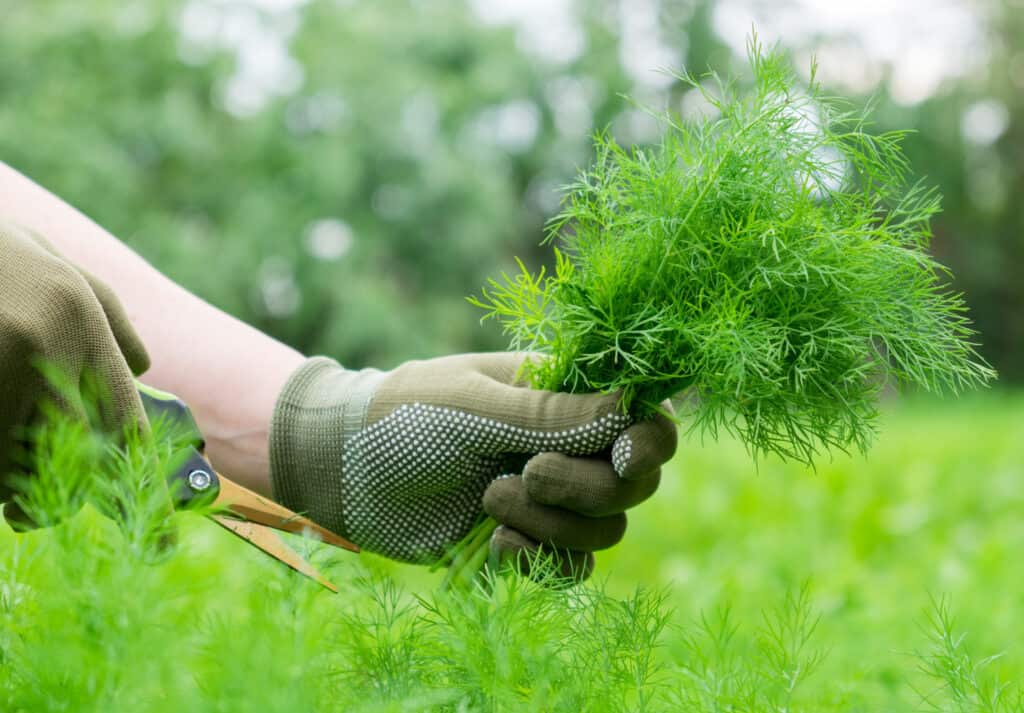
How to Store Herbs
Herbs can be used fresh, dried, or frozen, which means you have options for using now and using later. If you will be using them within a few days of harvesting, place the whole stem in a glass of water and keep it in the refrigerator. Or place the leaves in a damp but wrung-out paper towel inside a sealed plastic bag in the refrigerator.
If you have an abundance of leaves, you can dry them out and store them in sealed glass spice jars for later use. You can also chop them and freeze them for later.
Get creative with how you use them. Make some rosemary or basil butter to cook with, place them in a simmer pot, or infuse them in water and lemon juice for a room spray. Herbs have so many uses.
Diseases and Pests to Watch Out For
Fortunately, herbs deter most pests and insects with their scent, so you don’t usually need to worry about these. And if you plant them near other vegetables in your garden, they’ll provide a natural insect repellent to protect your other plants.
You do need to be concerned about fungal diseases, though. These are most commonly caused by too much moisture and darkness. Make sure your plants get plenty of sunshine throughout the day and water early in the day so they dry out a bit before dark. Give your plants a little breathing room between each other to encourage airflow.
Herbs are some of the easiest plants to grow, and they grow quickly and abundantly, giving you plenty to use in your kitchen and throughout your home. They make a perfect starter garden for a beginner gardener since you really can’t do anything wrong. Get creative and find new ways to put your wonderful, fresh-grown herbs to use in your kitchen, throughout your home, and even in gift-giving.
More Simple Living Resources:
- How to Cook with Fresh Herbs
- Easy Ways to Homestead No Matter Where You Live
- Simple Cooking Tips for the Kitchen
How to Grow Herbs for Beginners
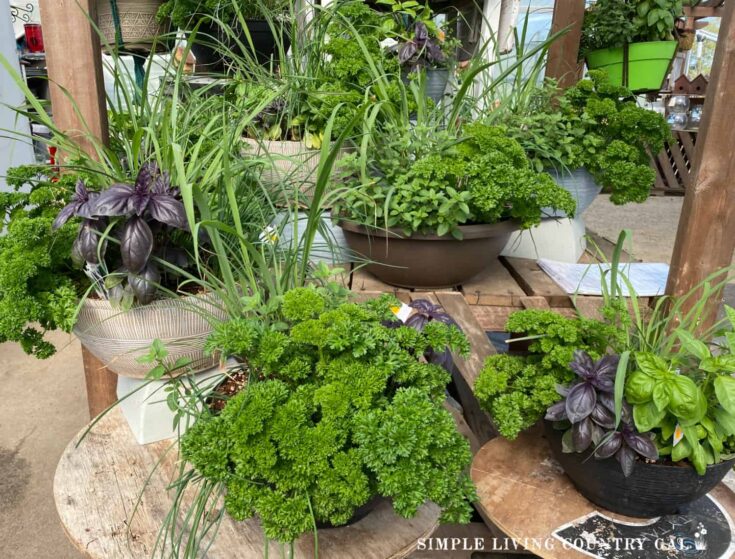
If you love the smell of fresh herbs and wish you had a farmers market right in your own backyard, then this guide on How to Grow Herbs for Beginners is exactly what you need. Learn the basics to get started growing your favorites from planting seeds to harvest.
Materials
- Herb Seeds
- Water
- Fertilizer or compost (optional)
- Lime (optional)
Tools
- Rake
- Hoe
- Shovel
- Garden or Grow Bags/Grow Containers
Instructions
- Add fertilizer or compost to the soil before planting.
- Plant seeds/start plants about 6"-8" apart. seeds need to be planted 6" deep.
- Keep soil moist but not too wet. Water a few times a week, about an inch of water per week. Avoid getting leaves wet.
- After a couple weeks you will want to pinch back some of your herbs as it will allow them more room for growth and thus branch out and grow better.
- Harvest or pinch off your herbs just before they flower.
- In fall, leave dead foliage on plant to help protect it throughout the winter.
- Store your herbs based on expected use time. Herbs can be stored fresh, dried, or frozen.
Notes
- Do not harvest more than 1/3 of the stem at a time for woody herbs (such as rosemary) as it will kill the plant.
- Herbs don’t need to be mulched with the exception of mint. It prefers moister growing conditions.
- Herbs can be pruned and harvested throughout the growing season when needed. Softer varieties can be cut back by half and still regrow and flourish. Woody types, like rosemary, should only be cut back by 1/3.
- Be careful when cutting back woody herbs not to remove the stem. Cutting all of their foliage will kill them.
Recommended Products
As an Amazon Associate and member of other affiliate programs, I earn from qualifying purchases.
-
Jobe’s Organics 09526 Organic All Purpose Granular Fertilizer 4-4-4, 4 lb
-
Jobe's 09365 Additive De-Acidifier, 6 lb, Lime Soil
-
Sereniseed Certified Organic Herb Seeds (10-Pack) – Non GMO, Heirloom – Seed Starting Video - Basil, Cilantro, Oregano, Thyme, Parsley, Lavender, Chives, Sage, Dill Seeds for Indoor & Outdoor Planting



